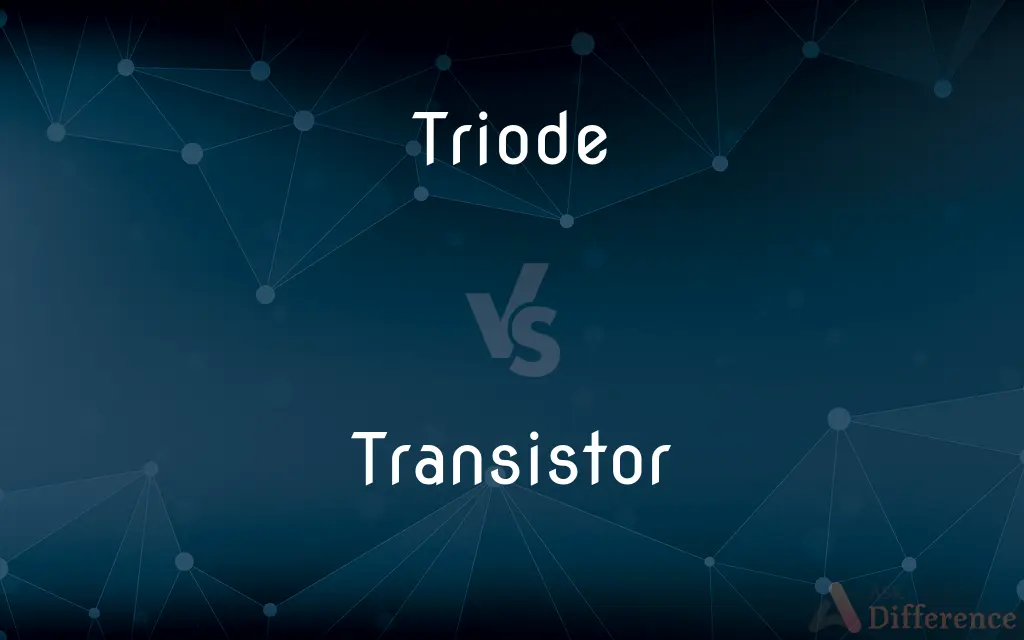Triode vs. Transistor — What's the Difference?
By Tayyaba Rehman & Urooj Arif — Updated on March 7, 2024
A triode amplifies signals using vacuum tube technology, while a transistor switches and amplifies electrical signals using semiconductor materials.

Difference Between Triode and Transistor
Table of Contents
ADVERTISEMENT
Key Differences
A triode is an electronic amplifying vacuum tube with three elements: the cathode, anode, and grid. This design allows it to amplify weak signals for radios, televisions, and early computers. On the other hand, a transistor is a solid-state device with at least three terminals for connection to an external circuit. Unlike triodes, transistors are smaller, more reliable, and consume less power, making them foundational in modern electronics.
The triode, invented in the early 20th century, was a breakthrough in electronic amplification, enabling long-distance telephone calls and radio broadcasts. However, transistors, developed in the mid-20th century, revolutionized electronics by offering superior performance in a much smaller package, paving the way for the miniaturization of electronic devices.
Triodes operate by controlling the flow of electrons in a vacuum between the cathode and anode, which is modulated by the grid. This process requires a high voltage and results in heat generation. Transistors, however, control current flow through semiconductor materials, like silicon, using electrical signals, making them more efficient and less prone to overheating.
Due to their size and power requirements, triodes have largely been replaced by transistors in most applications. Transistors are found in virtually all electronic devices today, from computers and smartphones to satellites. While triodes are still used in specialized applications, such as in high-end audio amplifiers and some radio transmitters, where their distinct sound quality is prized.
The primary advantage of triodes over transistors is their unique sound amplification characteristics, which some audiophiles prefer for its "warmer" tone. Conversely, transistors offer a cleaner sound with less distortion, which is more suitable for a wide range of audio applications.
ADVERTISEMENT
Comparison Chart
Basic Structure
Vacuum tube with cathode, anode, and grid
Solid-state device with at least three terminals
Operation Principle
Controls electron flow in a vacuum
Controls current flow through semiconductors
Invention Era
Early 20th century
Mid-20th century
Power Consumption
High, generates heat
Low, more energy-efficient
Application
Early radios, TVs, computers
Modern electronics, computing
Compare with Definitions
Triode
An electronic device that amplifies signals using a vacuum tube.
The triode was crucial for the development of early radio technology.
Transistor
Integral to the development of integrated circuits.
Without transistors, the microprocessor would not exist.
Triode
Still used in niche audio applications for its sound quality.
Many audiophiles treasure triodes in their vintage audio amplifiers.
Transistor
Offers greater reliability and smaller size compared to vacuum tubes.
The transistor's compact size revolutionized electronic design.
Triode
Features three main components: cathode, anode, and grid.
Adjusting the grid voltage in a triode changes the overall current flow.
Transistor
Can operate at low voltages and is energy-efficient.
The low power consumption of transistors enables longer battery life in portable devices.
Triode
Represents an early stage of electronic amplification technology.
The invention of the triode marked the beginning of electronic amplification.
Transistor
A semiconductor device used to amplify or switch electronic signals.
Transistors are the building blocks of modern electronic devices.
Triode
Requires high voltage to operate and generates heat.
Triodes fell out of favor due to their inefficiency and heat generation.
Transistor
Found in virtually every electronic device today.
From smartphones to satellites, transistors are ubiquitous in electronics.
Triode
A triode is an electronic amplifying vacuum tube (or valve in British English) consisting of three electrodes inside an evacuated glass envelope: a heated filament or cathode, a grid, and a plate (anode). Developed from Lee De Forest's 1906 Audion, a partial vacuum tube that added a grid electrode to the thermionic diode (Fleming valve), the triode was the first practical electronic amplifier and the ancestor of other types of vacuum tubes such as the tetrode and pentode.
Transistor
A transistor is a semiconductor device used to amplify or switch electronic signals and electrical power. Transistors are one of the basic building blocks of modern electronics.
Triode
An electron tube used mostly for signal amplification, consisting of a cathode, an anode, and an intervening wire mesh called a control grid.
Transistor
A semiconductor device with three connections, capable of amplification in addition to rectification.
Triode
A thermionic valve containing an anode, a cathode, and a control grid; small changes to the charge on the grid control the flow from cathode to anode, which makes amplification possible.
Transistor
A small electronic device containing a semiconductor and having at least three electrical contacts, used in a circuit as an amplifier, detector, or switch.
Triode
A thermionic vacuum tube having three electrodes; fluctuations of the charge on the grid control the flow from cathode to anode which making amplification possible
Transistor
Any of various devices serving the same purpose but employing a different technology
An optical transistor.
Transistor
A transistor radio.
Transistor
(semiconductors) A solid-state semiconductor device, with three terminals, which can be used for amplification, switching, voltage stabilization, signal modulation, and many other functions.
Transistor
A transistor radio.
Transistor
A component used in electronic devices consisting of three regions of at least two types of a semiconducting material, such as doped silicon, connected to each other and to three electrodes in a conducting path so as to modify the current or voltage in an electronic circuit.
Transistor
A semiconductor device capable of amplification
Common Curiosities
Why are triodes considered inefficient?
Triodes are considered inefficient because they require high operating voltages and generate significant heat.
What is a triode used for?
A triode is used to amplify audio and radio signals in early electronic devices.
Can transistors replace triodes in all applications?
While transistors have replaced triodes in most applications due to their advantages, triodes are still preferred in some high-end audio applications for their unique sound quality.
What makes transistors foundational in modern electronics?
Transistors' ability to function efficiently at low power levels and their compact size make them foundational in the miniaturization and advancement of modern electronics.
Are triodes still manufactured today?
Yes, triodes are still manufactured for use in specialized areas like high-quality audio equipment and some musical instruments.
What was the first major application of triodes?
The first major application of triodes was in amplifying telephone and radio signals.
How have transistors impacted the computing industry?
Transistors have enabled the creation of compact, powerful, and energy-efficient computers and other digital devices.
How does a transistor differ from a triode?
A transistor differs from a triode in structure, operation, and efficiency, being more compact, reliable, and energy-efficient.
How do transistors amplify signals?
Transistors amplify signals by controlling the flow of electrical current through semiconductor materials with an input voltage.
Why did the invention of the transistor revolutionize electronics?
The invention of the transistor revolutionized electronics by allowing for smaller, more reliable, and energy-efficient devices.
Do modern audio devices still use triodes?
While most modern audio devices use transistors for efficiency, some high-end and vintage audio devices still use triodes for their characteristic sound.
What are the main components of a triode?
The main components of a triode are the cathode, anode, and control grid.
Can triodes operate at low voltages like transistors?
No, triodes require higher voltages to operate compared to transistors.
Is the sound quality of a triode better than that of a transistor?
Some audiophiles believe triodes produce a warmer, more pleasant sound, although this is subjective and depends on the application.
What materials are used to make transistors?
Transistors are made from semiconductor materials, commonly silicon.
Share Your Discovery

Previous Comparison
Hillock vs. Hummock
Next Comparison
Judahite vs. JewAuthor Spotlight
Written by
Tayyaba RehmanTayyaba Rehman is a distinguished writer, currently serving as a primary contributor to askdifference.com. As a researcher in semantics and etymology, Tayyaba's passion for the complexity of languages and their distinctions has found a perfect home on the platform. Tayyaba delves into the intricacies of language, distinguishing between commonly confused words and phrases, thereby providing clarity for readers worldwide.
Co-written by
Urooj ArifUrooj is a skilled content writer at Ask Difference, known for her exceptional ability to simplify complex topics into engaging and informative content. With a passion for research and a flair for clear, concise writing, she consistently delivers articles that resonate with our diverse audience.
















































